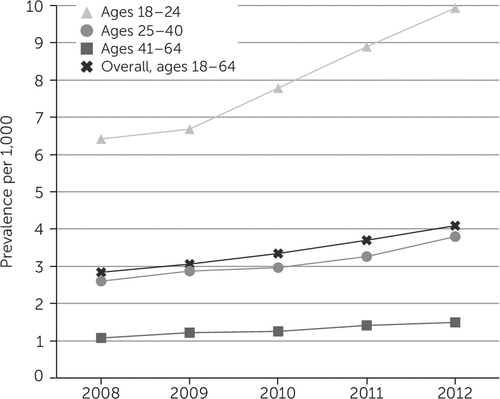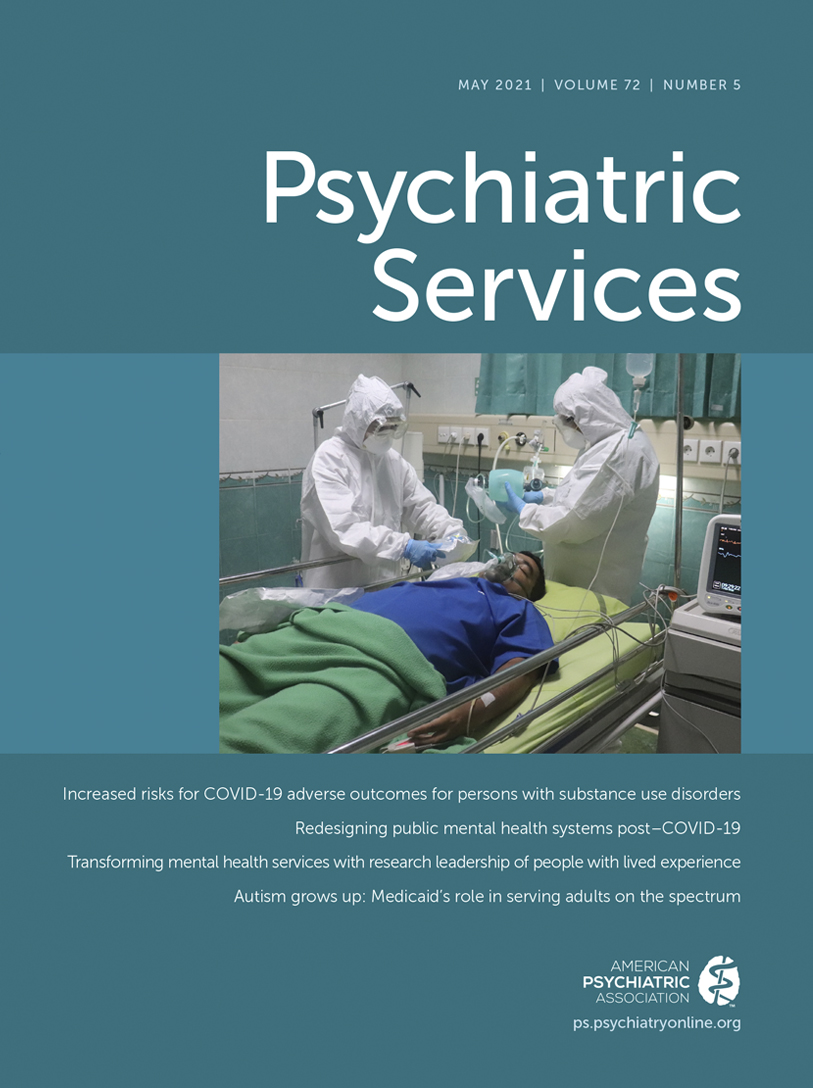Autism Grows Up: Medicaid’s Role in Serving Adults on the Spectrum
With the increase in prevalence of autism spectrum disorder (ASD) over recent years (1, 2), much attention has been paid to U.S. children and adolescents in need of services. However, half a million youths with ASD will age into adulthood over the next decade (3), and many adults are already in need of long-term services and supports. Medicaid is the primary source of health care coverage for these individuals (4), but little is known about the composition of the adult population with ASD enrolled in Medicaid.
We examined Medicaid Analytic eXtract data including all individuals under age 65 with claim(s) of ASD (clinical modification code: 299.xx) and a random sample of 3,358,220 Medicaid beneficiaries without ASD or intellectual disability (ID) (317.xx–319.xx) between 2008 and 2012. Figure 1 shows the administrative prevalence of individuals ages 18–64 enrolled in Medicaid, by age category. The numerator includes individuals with 12-month continuous enrollment and either one inpatient or two outpatient visits for which ASD was a diagnosis. The denominator is the sum of the numerator plus the total Medicaid population without ASD in that age group with 12-month continuous enrollment. We assumed that the percentage of Medicaid beneficiaries without ASD with 12-month continuous enrollment was the same in each year as in our simple random sample of 3.3 million Medicaid recipients without ASD or ID, ranging from 55% (2008) to 60% (2012).

FIGURE 1. Administrative prevalence of autism spectrum disorder in the adult Medicaid population with 12-month annual enrollment, 2008–2012a
aSource: Authors’ analysis of Medicaid Analytic eXtract data.
During 2008–2012, the prevalence of ASD among adults ages 18–64 enrolled in Medicaid with 12-month continuous annual enrollment rose from 2.8 to 4.1 per 1,000 (Figure 1). However, the prevalence of ASD for adults ages 18–24 with ASD rose from 6.4 to 9.9 per 1,000. For adults ages 25–40, prevalence rose from 2.6 to 3.8 per 1,000, whereas for adults ages 41–64, increases were more modest (1.1 to 1.5 per 1,000). Given 77 million individuals enrolled in the Medicaid program at some point in 2012, our results imply that 46 million Medicaid recipients had 12-month continuous enrollment, of whom 78,261 were receiving services for ASD.
The higher prevalence of ASD among younger adults compared with older adults suggests additional services and supports for adults with autism, such as those that increase community integration and improve employment opportunities, may be needed in the future. These results underline the importance of identifying effective and efficient service delivery models within Medicaid to serve the growing number of adults with ASD.
1 : Prevalence of autism spectrum disorder among children aged 8 years—autism and developmental disabilities monitoring network, 11 sites, United States, 2014 . MMWR Surveill Summ 2018 ; 67 : 1 – 23 Crossref, Medline, Google Scholar
2 Developmental Disabilities Monitoring Network Surveillance Year 2010 Principal Investigators, Centers for Disease Control and Prevention: Prevalence of autism spectrum disorder among children aged 8 years—autism and developmental disabilities monitoring network, 11 sites, United States, 2010 . MMWR Surveill Summ 2014 ; 63 : 1 – 21 Medline, Google Scholar
3 Youth With Autism: Roundtable Views of Services Needed During the Transition Into Adulthood. GAO-17-109. Washington, DC, US Government Accountability Office, 2016 Google Scholar
4 Behavioral Health Services . Baltimore , , https://www.medicaid.gov/medicaid/benefits/bhs/index.html Google Scholar



